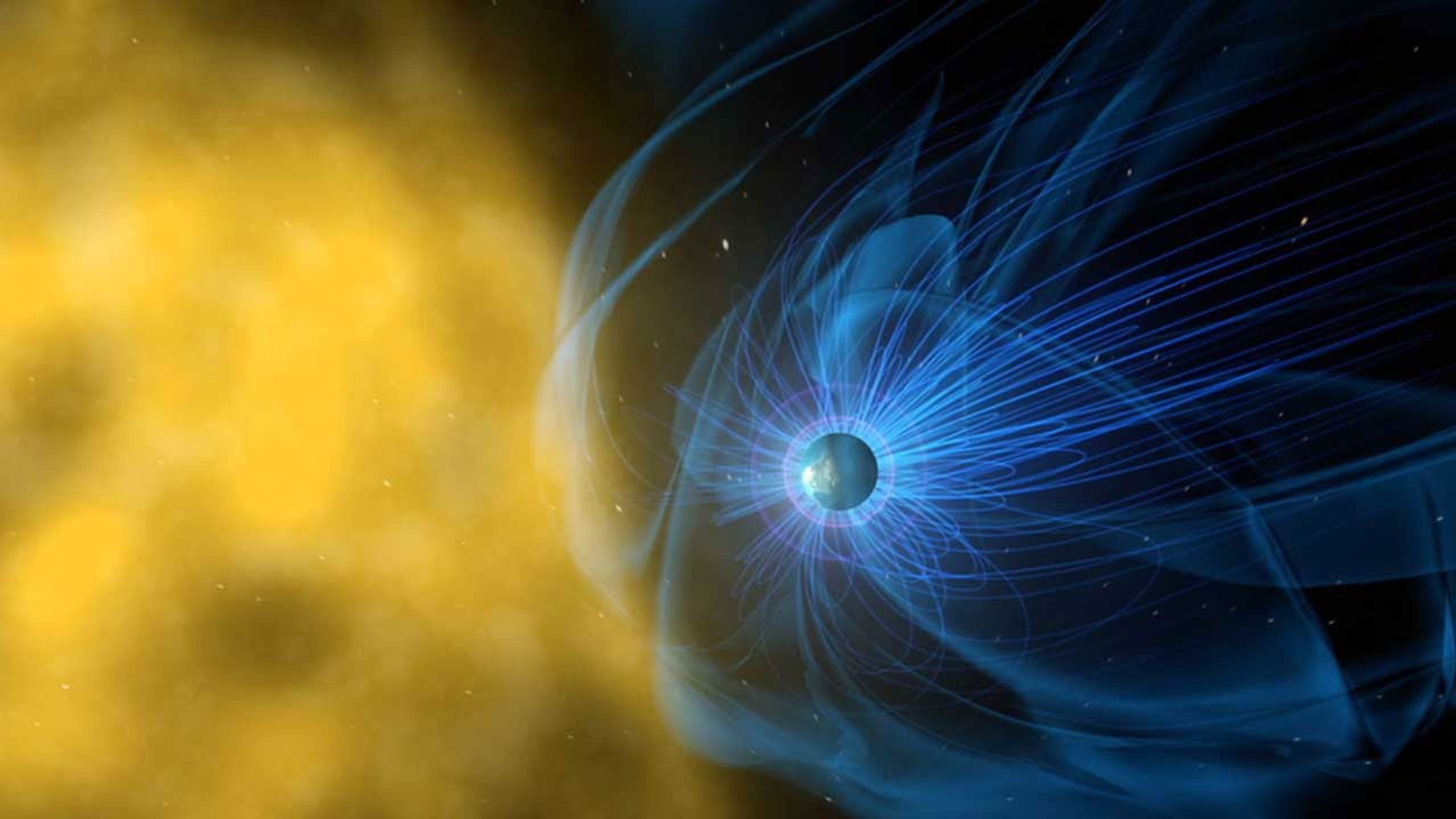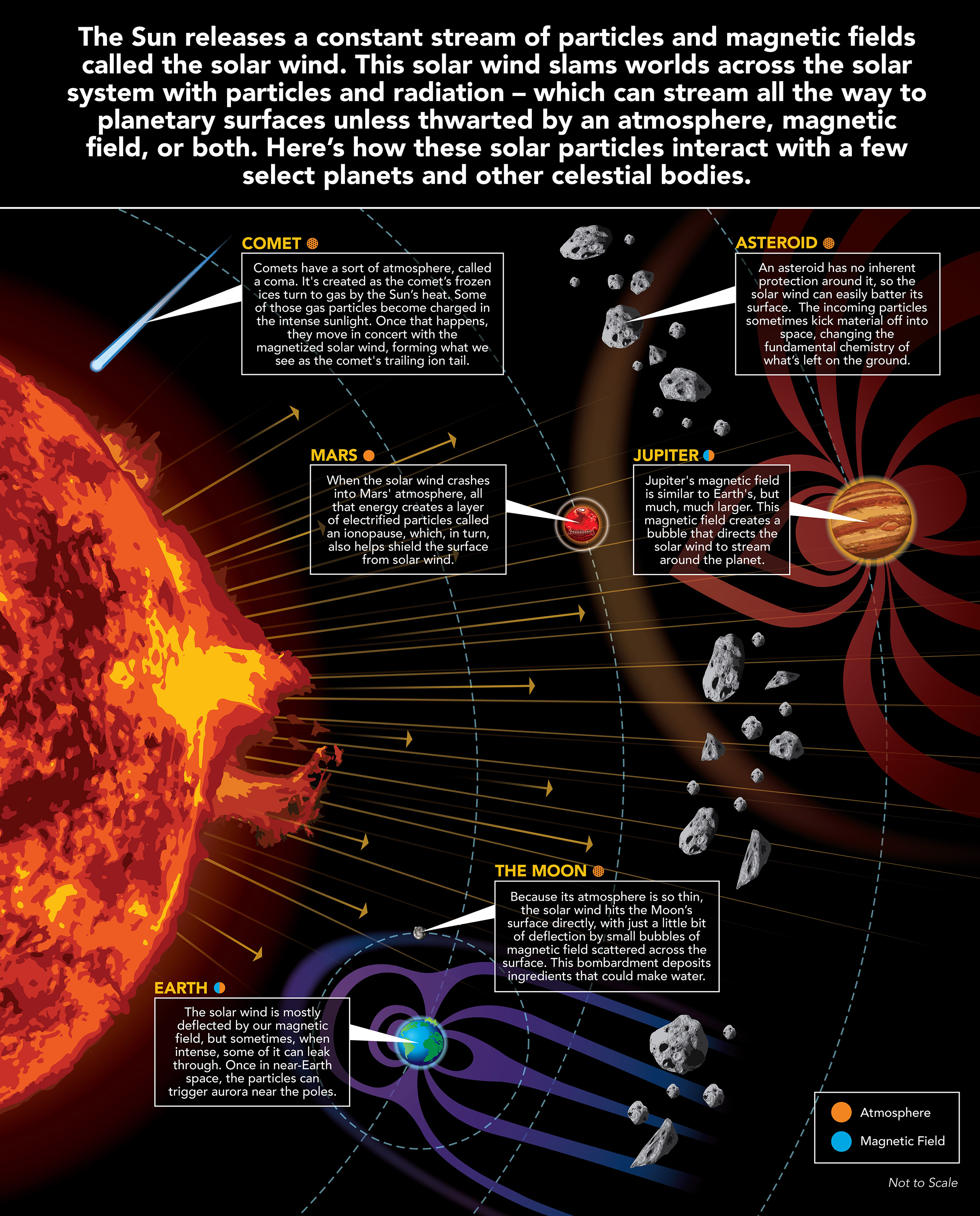The Solar Wind is a stream of plasma (charged particles) that originates from the Corona, the Sun's outermost atmospheric layer, and continuously propagates into interplanetary space, reaching supersonic speeds. This plasma is primarily composed of high-energy electrons, protons, and a smaller amount of alpha particles (helium nuclei), along with trace amounts of heavy ions.
The Solar Wind fills the entire Solar System, creating a giant bubble called the "heliosphere," and constantly interacts with the magnetic fields, atmospheres, and even surfaces of planets. This particle stream, which is divided into two main types, "slow" and "fast," based on its velocity, density, and the coronal region of its origin, is the main driving force behind space weather events on Earth, such as the auroras and geomagnetic storms.

The Effect of Solar Winds on Earth (NASA)
Historical Observations and Discovery
The idea of a continuous stream of particles from the Sun first emerged from observations of comets in the 19th and 20th centuries. These observations revealed that a comet's ion tail always points directly away from the Sun, regardless of its orbital motion. In the 1950s, German astrophysicist Ludwig Biermann proposed that this phenomenon could only be explained if a continuous flow of particle radiation from the Sun (termed "solar corpuscular radiation" at the time) was pushing the tail away.
The theoretical foundation for this idea was laid in 1958 by astrophysicist Eugene Parker. Parker mathematically demonstrated that given the extremely high temperature of the Sun's corona, which exceeds one million Kelvin, this layer could not remain in a state of static equilibrium. The thermal pressure of the corona would inevitably overpower the Sun's gravitational force, causing the plasma to continuously expand into space at supersonic speeds. Parker named this continuous plasma stream the "Solar Wind." Although Parker's theory was initially met with skepticism in the scientific community, it was definitively confirmed by direct measurements made by the Soviet spacecraft Luna 1 in 1959 and NASA's Mariner 2 spacecraft in 1962.

Solar Wind Infographic (NASA)
Formation Mechanism and the Coronal Heating Problem
The Solar Wind originates from the Sun's corona, where temperatures exceed one million Kelvin. This is hundreds of times hotter than the Sun's surface (the photosphere) below it, which has a temperature of about 5,800 Kelvin. The physical mechanism that causes the plasma to heat to such extreme temperatures as it moves away from the surface is known as the "Coronal Heating Problem" and is one of the most significant unsolved problems in modern astrophysics. The two main theories proposed to explain this problem are:
- Wave Heating Theory: According to this theory, energy is transported from the convection zone beneath the Sun's surface to the corona via various plasma waves (especially Alfvén waves) that travel along magnetic field lines. When these waves reach the less dense environment of the corona, they transfer their energy to the plasma, heating it.
- Magnetic Reconnection (Nanoflare) Theory: The corona possesses a highly complex and dynamic network of magnetic fields. As these magnetic field lines are constantly twisted, stretched, and tangled, "magnetic reconnection" events occur, where they abruptly break and reconnect in a different configuration. These events release stored magnetic energy in the form of numerous small, continuous bursts ("nanoflares"). The collective effect of these countless small explosions is thought to heat the corona.
Regardless of which mechanism is dominant, once the coronal plasma reaches these extreme temperatures, the thermal energy of the particles becomes sufficient to escape the Sun's gravitational pull, and the plasma expands into space as the Solar Wind.
Properties and Composition of the Solar Wind
The properties of the Solar Wind vary with distance from the Sun and depending on the Sun's activity cycle. Typical values measured near Earth's orbit (1 Astronomical Unit - AU) are as follows:
Velocity and Density
- Slow Solar Wind: Velocity is approximately 300-500 km per second, with a density of about 5-10 particles per cubic centimeter.
- Fast Solar Wind: Velocity reaches approximately 700-800 km per second, but it is less dense (~3 particles per cubic centimeter).
Temperature
- The proton temperature is typically 100,000 K, while the electron temperature is slightly lower. Due to the plasma's low density, these temperatures differ from the conventional perception of heat and represent the kinetic energy of the particles.
Composition
- The Solar Wind is predominantly composed of ionized hydrogen (~95%) (protons and electrons). Alpha particles (helium nuclei) make up a large portion of the remainder (~4-5%). Ions of heavier elements such as carbon, nitrogen, oxygen, neon, magnesium, silicon, and iron are also present in trace amounts.
Types and Sources of the Solar Wind
The speed and density of the Solar Wind depend on the structure of the coronal region from which it originates.
- Slow Solar Wind: Its source is the bright, dense coronal structures known as "helmet streamers," which are formed by closed magnetic field loops near the Sun's equatorial regions. Plasma leaks out from these regions more slowly and irregularly.
- Fast Solar Wind: Its source is regions called "coronal holes," where magnetic field lines are open, extending from the Sun out into interplanetary space. These holes appear as dark areas in X-ray telescopes because they are cooler and less dense than their surroundings. The open magnetic field lines act as a "highway" for plasma to escape into space at very high speeds.
Interplanetary Magnetic Field (IMF) and the Heliosphere
The Solar Wind carries the Sun's magnetic field with it, creating the Interplanetary Magnetic Field (IMF) that fills interplanetary space. As the Sun rotates on its axis, these outward-propagating magnetic field lines form a spiral pattern, similar to the water from a rotating garden sprinkler. This structure is called the "Parker Spiral."
The magnetic plasma bubble created by the Solar Wind is called the Heliosphere. The Heliosphere protects the Solar System from a significant portion of galactic cosmic rays. The boundaries of this bubble are defined as follows:
- Termination Shock: The boundary where the Solar Wind's speed slows from supersonic to subsonic. The Voyager 1 and 2 spacecraft have crossed this boundary.
- Heliosheath: The region between the termination shock and the heliopause, containing slower and more turbulent solar wind plasma.
- Heliopause: The theoretical boundary where the outward pressure of the Solar Wind is balanced by the inward pressure of the interstellar medium. This is considered the magnetic edge of the Solar System.
Research Missions
Many space missions have been conducted to understand the Solar Wind. Historic missions include Mariner 2, Pioneer 6-9, and Ulysses, which studied its three-dimensional structure by passing over the Sun's poles. Currently, satellites positioned at the L1 point, such as ACE (Advanced Composition Explorer) and WIND, continuously monitor the properties of the Solar Wind before it reaches Earth. SOHO (Solar and Heliospheric Observatory) observes events like coronal mass ejections, which are sources of the Solar Wind. The most significant mission in this field is the Parker Solar Probe. This spacecraft is repeatedly diving into the Sun's corona to directly sample the region where the Solar Wind is born and collect data aimed at solving the coronal heating problem.

